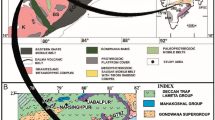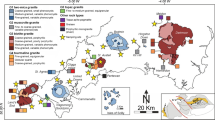Abstract
Borate minerals of the ludwigite group (LGM) and szaibélyite in association with hydroxylclinohumite, clinochlore, a serpentine mineral, magnesian magnetite, spinel, magnesite, dolomite and sulphide minerals, occur in a magnesian exoskarn in the R-20 borehole located in the Vysoká – Zlatno Cu-Au porphyry-skarn deposit, located within the Štiavnica Neogene stratovolcano, Western Carpathians, central Slovakia. The skarn is developed along the contact of Miocene granodiorite to quartz-diorite porphyry and a Middle-Upper Triassic dolomite-shale-psammite-anhydrite sedimentary sequence. The boron minerals were investigated by electron probe micro-analyser (EPMA) and micro-Raman techniques. The source of boron could have been from the granodiorite/quartz diorite intrusion; however some supply of B from adjacent evaporite-bearing sediments is also possible. Based on textural and compositional data, the minerals originated during two stages. (1) An early high-temperature, contact-metamorphic and metasomatic stage comprises coarse-crystalline aggregate of LGM (types 1 to 3) in association with hydroxylclinohumite, magnetite, and rarely spinel inclusions in LGM. Compositional variations of LGM show a crystallization sequence from early azoproite [≤17 wt% TiO2; ~0.40 atoms pre formula unit (apfu) Ti, which correspond to ≤79 mol% of the Mg2(Mg0.5Ti0.5)O2(BO3) end-member], Ti-Al-rich members of LGM, “aluminoludwigite “[≤14 wt% Al2O3; ≤0.53 apfu, ≤53 mol% of Mg2AlO2(BO3) end-member] and Al-rich ludwigite in the central zone of crystals, to Ti-Al-poor ludwigite in outer parts of crystals. (2) Minerals of the late retrograde serpentinization and hydrothermal stage form irregular veinlets and aggregates, including partial alteration of hydroxylclinohumite to the serpentine-group mineral and clinochlore, replacement of LGM by szaibélyite, formation of the latest generation of Fe-rich, Ti-Al poor ludwigite in veinlets (type 4), and precipitation of dolomite, magnesite and sulphide minerals (valleriite, sphalerite, chalcopyrite). The distinct compositional zoning of the LGM documents a complex evolution of the skarn beginning with a high-temperature stage 1 and ending with a low-temperature overprint, stage 2.







Similar content being viewed by others
References
Aleksandrov SM (1961) Some geochemical peculiarities of the process of szaibelyitization of magnesian-iron borates. Geokhimiya 6:493–499 (in Russian)
Aleksandrov SM (2007) Endogenous transformations of kotoite in calciphyres at magnesian-skarn deposits of boron. Geochem Int 45:666–684
Aleksandrov SM (2008) Geochemical features of the endogenous hydration of magnesium borates. Geochem Int 46:578–594
Aleksandrov SM, Troneva MA (2008) Heterovalent isomorphism in the magnesium–iron borates. Geochem Int 46:800–813
Aleksandrov SM, Troneva MA (2009) Composition and genesis of endogenous borates from the Pitkáranta ore field, Karelia. Geochem Int 47:914–929
Aleksandrov SM, Troneva MA (2011) Genesis and composition of endogenous borates in the skarns of the eastern and central Pyrenees. Geochem Int 49:802–814
Anovitz LM, Grew ES (1996) Mineralogy, petrology and geochemistry of boron: an introduction. In: Grew ES, Anovitz LM (eds) Boron: mineralogy, petrology and geochemistry, Rev Mineral, vol 33. Washington, D.C, Mineral Soc Am, pp 1–40
Appel PWU, Brigatti MF (1999) Ludwigite from central Sweden: new data and crystal structure refinement. Mineral Mag 63:511–518
Bloise A, Barrese E (2009) Synthesis of isomorphic vonsenite-ludwigite series. N Jahrb Mineral Abh 186:345–350
Bloise A, Barrese E, Apollaro C, Miriello D (2010) Synthesis of ludwigite along the Mg2FeBO5 – Mg2AlBO5 join. N Jahrb Miner Abh 187:217–223
Bonazzi P, Menchetti S (1989) Contribution to the crystal chemistry of the minerals of the ludwigite–vonsenite series. N Jahrb Mineral Mh 1989:69–83
Chernyshev IV, Konečný V, Lexa J, Kovalenker VA, Jeleň S, Lebedev VA, Goltsman YV (2013) K-Ar and Rb-Sr geochronology and evolution of the Štiavnica Stratovolcano (Central Slovakia). Geol Carpath 64:327–351
Demko R, Kubiš M, Bazarnik J (2011) Petrology and geochemistry of acid aplites from the Hodruša-Štiavnica intrusive complex in the Rumplovská area. Miner Slov 43:215–226 (in Slovak, English summary)
Enholm Z (2016) Mineral chemistry and parageneses of oxyborates in metamorphosed Fe-Mn oxide deposits. Uppsala Univ, Sweden, Department of Earth Sciences, 98 p
Frost RL (2011) Raman spectroscopy of selected borate minerals of the pinakolite group. J Raman Spectrosc 42:540–543
Frost RL, Scholz R, López A, Xi Y, Belotti FM (2014) Infrared and Raman spectroscopic characterization of the borate mineral vonsenite. Spectrosc Lett 47:512–517
Frost RL, Scholz R, López A, Belotti FM (2015) The molecular structure of the borate mineral szaibelyite MgBO2(OH) – a vibrational spectroscopic study. J Mol Struct 1089:20–24
Galuskin EV, Kusz J, Starikova AE, Pertsev NN (2010) Azoproite crystals with nanorod inclusions of baddeleyite. Acta Mineral-Petrogr Abstr Ser 6:482
Galuskina IO, Kadiyski M, Armbruster T, Galuskin EV, Pertsev NN, Dzierżanowski P, Wrzalik R (2008) A new natural phase in the system Mg2SiO4–Mg2BO3F–Mg2BO3(OH): composition, paragenesis and structure of OH-dominant pertsevite. Eur J Mineral 20:951–964
Grew ES, Yates MG, Adams PM, Kirkby R, Wiedenbeck M (1999) Harkerite and associated minerals in marble and skarn from Crestmore quarry, Riverside County, California and Cascade slide, Adirondack Mountains, New York. Can Mineral 37:277–296
Grice JD (2008) Szaibélyite: crystal structure analysis and hydrogen bonding. Can Mineral 46:671–677
Grice JD, Gault RA, Van Velthuizen J (2005) Borate minerals of the Penobsquis and millstream deposits, southern New Brunswick, Canada. Can Mineral 43:1469–1487
Helvaci C, Alonso RN (2000) Borate deposits of Turkey and Argentina; a summary and geological comparison. Turk J Earth Sci 9:1–27
Ilinca G (2012) Upper cretaceous contact metamorphism and related mineralization in Romania. Acta Mineral-Petrogr Abstr Ser 7:59–64
Irwin MB, Peterson RC (1999) The crystal structure of ludwigite. Can Mineral 37:939–943
Kanishchev AD, Pertsev NN (1969) Kotoite and alumoludwigite mineralization in the Korotkovskoie skarn deposit (Central Transbaikalia). Geol Rud Mestorozh 11:42–51 (in Russian)
Koděra M, Andrusovová-Vlčeková G, Belešová O, Briatková D, Dávidová Š, Fejdiová V, Hurai V, Chovan M, Nelišerová E, Ženiš P (1986) Topographic mineralogy of Slovakia, vol 1. Veda, Bratislava 577 p (in Slovak)
Koděra M, Andrusovová-Vlčeková G, Belešová O, Briatková D, Dávidová Š, Fejdiová V, Hurai V, Chovan M, Nelišerová E, Ženiš P (1990) Topographic mineralogy of Slovakia, vol 3. Veda, Bratislava 499 p (in Slovak)
Koděra P, Rankin AH, Lexa J (1998) Evolution of fluids responsible for iron skarn mineralisation: an example from the Vyhne–Klokoč deposit, Western Carpathians, Slovakia. Mineral Petrol 64:119–147
Koděra P, Lexa J, Fallick AE (2010) Formation of the Vysoká–Zlatno Cu–Au skarn–porphyry deposit, Slovakia. Mineral Depos 45:817–843
Kohút M, Danišík M (2013) Geochronometry of the granitic rocks from the Central Slovakian Neovolcanic field – an evidence for rapid uplift. In: Broska I, Tomašových A (eds) Geological evolution of the western Carpathians: new ideas in the field of inter-regional correlations. Abstract book. Geological Inst, Slovak Academy of Sciences, Bratislava, pp 25–26
Konev AA, Lebedeva VS, Kashayev AA, Ushchapovskaya ZF (1971) Azoproite, a new mineral of the ludwigite group. Int Geol Rev 13:1183–1188
Kroumova E, Aroyo MI, Perez-Mato JM, Kirov A, Capillas C, Ivantchev S, Wondratschek H (2003) Bilbao crystallographic server: useful databases and tools for phase transitions studies. Phase Transit 76:155–170
Kwak TAP, Nicholson M (1988) Szaibelyite and fluoborite from the St Dizier Sn-borate skarn deposit, NW Tasmania, Australia. Mineral Mag 52:713–716
Lafuente B, Downs RT, Yang H, Stone N (2015) The power of databases: the RRUFF project. In: Armbruster T, Danisi RM (eds) Highlights in mineralogical crystallography. W. de Gruyter, Berlin, pp 1–30
Leite CAF, Guimarães RB, Fernandes JC, Continentino MA, Paschoal CWA, Ayala AP, Guedes I (2002) Temperature-dependent Raman scattering study of Fe3O2BO3 ludwigite. J Raman Spectrosc 33:1–5
Li D, Peng M, Bancroft GM (1994) The vibrational spectra and structure of nordenskiöldine. Can Mineral 32:81–86
Marincea S (1999a) Ludwigite from the type locality, Ocna de Fier, Romania: new data and review. Can Mineral 37:1343–1362
Marincea S (1999b) Mineralogical data on magnesian borates and associated minerals from Pietroasa skarn deposit, Romania. In: Stanley CJ (ed) Mineral deposits: processes to processing. Balkema, Rotterdam, pp 1051–1054
Marincea S (2000) The influence of Al on the physical and crystallographic properties of ludwigite in three Romanian occurrences. Eur J Mineral 12:809–823
Marincea S (2001a) Magnesian borates and associated minerals in the Cacova Ierii skarn deposit (Apuseni Mountains, Romania). Geonomos 8:1–7
Marincea S (2001b) New data on szaibelyite from the type locality, Băiţa Bihor, Romania. Can Mineral 39:111–127
Marsina K (ed) (1999) Geochemical atlas of the Slovak Republic. Part III, rocks. Dionýz Štúr geological Institute, Bratislava, 134 p
Marsina K, Hojstričová V, Konečný V, Konečný P, Lexa J, Rojkovičová Ľ, Žáková E (1995) Comparison of the skarn–Cu-porphyry deposits in central parts of the Štiavnica Stratovolcano and their prognostic evaluation. Unpublished exploration report, State Dionýz Štúr Geological Institute, Bratislava 119 p (in Slovak)
Ortí F, Helvaci C, Rosell L, Gündoğan I (1998) Sulphate-borate relations in an evaporitic lacustrine environment: the Sultançayir gypsum (Miocene, western Anatolia). Sedimentology 45:697–710
Pertsev NN (1991) Magnesian skarns. In: Aksyuk AM (ed) Skarns – their genesis and metallogeny. Theophrastus Publications, Athens, pp 299–324
Pertsev NN, Aleksandrov SM (1964) Ludwigite with a high content of alumina. Zap Vses Mineral Obshch 93:13–20 (in Russian)
Pertsev NN, Schreyer W, Armbruster T, Bernhardt H-J, Medenbach O (2004) Alumino-magnesiohulsite, a new member of the hulsite group, in kotoite marble from east of Verkhoyansk, Sakha-Yakutia, Russia. Eur J Mineral 16:151–161
Pouchou JL, Pichoir F (1985) “PAP” procedure for improved quantitative microanalysis. Microbeam Anal 20:104–105
Schaller WT, Vlisidis AC (1961) The composition of the aluminian ludwigite from Crestmore, Califomia. Am Mineral 46:335–339
Shannon RD (1976) Revised effective ionic radii and systematic studies of interatomic distances in halides and chalcogenides. Acta Crystallogr A32:751–767
Takéuchi Y, Kogure T (1992) The structure type of ludwigite. Z Krist 200:161–167
Takéuchi Y, Kudoh Y (1975) Szaibelyite, Mg2(OH)[B2O4(OH)]: crystal structure, pseudosymmetry, and polymorphism. Am Mineral 60:273–279
Takéuchi Y, Watanabe T, Ito T (1950) The crystal structures of warwickite, ludwigite and pinakiolite. Acta Crystallogr 3:98–107
Tančić P, Dimitrijević R, Poznanović M, Pačevski A, Sudar S (2012) Crystal structure and chemical composition of ludwigite from Vranovac ore deposit (Boranja Mountain, Serbia). Acta Geol Sin 86:524–1538
Uher P, Milovská S, Milovský R, Koděra P, Bilohuščin V (2015) Kerimasite, {Ca3}[Zr2](SiFe 3+ 2)O12 garnet from the Vysoká–Zlatno skarn, Štiavnica stratovolcano, Slovakia. Mineral Mag 79:715–733
Wachowiak J, Toboła T (2014) Phase transitions in the borate minerals from the Kłodawa salt dome (central Poland) as indicators of temperature processes in salt diapirs. Geol Quart 58:43–554
Woodford DT, Sisson VB, Leeman WP (2001) Boron metasomatism of the Alta stock contact aureole, Utah: evidence from borates, mineral chemistry and geochemistry. Am Mineral 86:513–533
Wopenka B, Freeman JJ, Grew ES (1999) Raman spectroscopic identification of B-free and B-rich kornerupine (prismatine). Am Mineral 84:550–554
Acknowledgements
Authors thank Ľ. Rojkovičová for mineral samples, and P. Konečný and V. Kollárová for their assistance during the EPMA analytical work. We also acknowledge reviews of Edward S. Grew and Evgeny Galuskin as well as comments of guest editor Ray Macdonald and editor-in-chief Lutz Nasdala, which greatly improved the manuscript. The present work was supported by the Slovak Research and Development Agency under the projects APVV-0537-10 and APVV-15-0050, as well as the VEGA-1/0560/15 project of Ministry of Education, Slovak Republic.
Author information
Authors and Affiliations
Corresponding author
Additional information
Editorial handling: R. Macdonald
Rights and permissions
About this article
Cite this article
Bilohuščin, V., Uher, P., Koděra, P. et al. Evolution of borate minerals from contact metamorphic to hydrothermal stages: Ludwigite-group minerals and szaibélyite from the Vysoká – Zlatno skarn, Slovakia. Miner Petrol 111, 643–658 (2017). https://doi.org/10.1007/s00710-017-0518-y
Received:
Accepted:
Published:
Issue Date:
DOI: https://doi.org/10.1007/s00710-017-0518-y




